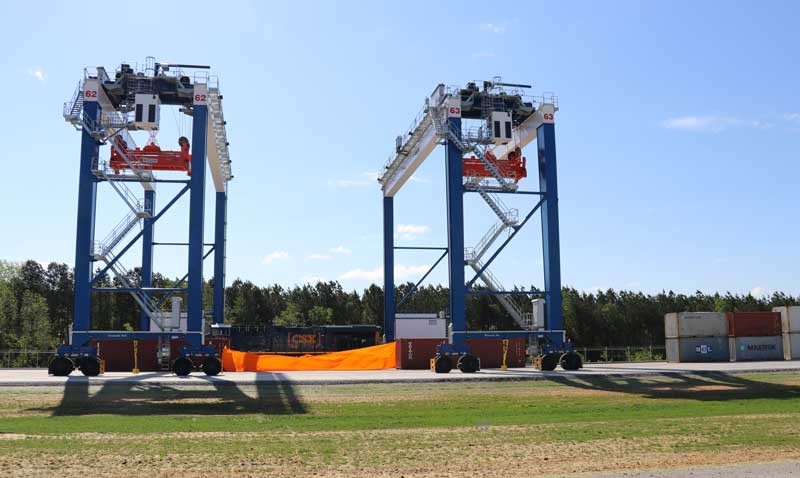News | April 17 2018

South Carolina’s second inland port, Inland Port Dillon, is open for business.
In international trade, freight or goods being transported usually are sent in large containers that are, in turn, transported on ships. Those ships arrive at a port, such as Charleston, and the container is then offloaded onto trucks or rail to be transported to the final destination.
With the addition of the Inland Port Dillon, instead of being offloaded in Charleston, some of the containers will be offloaded in Dillon and transported via the CSX A rail line that runs from Jacksonville, Fla. to Baltimore and points north, Interstate 95 and, when it’s constructed, Interstate 73 to their final destinations.
The process is reversed for freight being transported overseas. Once in containers, the goods will be transported by truck to the Dillon Inland Port, where the container will then be transported via specialized crane to rail to ultimately be transported to the Port of Charleston to be placed on a cargo ship and sent abroad.
It is expected the Dillon Inland Port will see 45,000 container movements from truck to rail in its first year. The state’s first inland port, in Greer, started with 50,000 containers movements and was up to 124,817 in 2017.
The Dillon Inland Port is located within the Carolinas I-95 Mega Site located just off of exit 190 of Interstate 95. From that location, access to the entire Eastern seaboard, and much of the population of the United States, is provided by Interstate 95 and the CSX A line. Once construction is finished, Interstate 73 will provide access to the Midwest. It is planned to run from the Canada-Michigan border to Myrtle Beach.
It is hoped that development of the port will be the instigator of job growth in Dillon, Marion and Marlboro counties, rural counties that have suffered in recent years. According to the 2010 census, median income was $26,818 in Dillon County, $30,629 in Marion County and $27,688 in Marlboro County. Median income for South Carolina is $47,238.
Several politicians spoke Monday morning at the ceremony opening the port, including Rep. Jackie “Coach” Hayes of the South Carolina House of Representatives, S.C. Sen. Kent Williams, S.C. Senate President Pro Tempore Hugh K. Leatherman Sr., U.S. Rep. Tom Rice of South Carolina’s 7th Congressional District and S.C. Gov. Henry McMaster. plus various dignitaries, including Jim Newsome, president and CEO of the South Carolina Ports Authority; Dillon County Administrator Rodney Berry; CSX Industrial Development Manager Kellen Riley; and Robby Roberson, vice president of East Coast distribution operations for Harbor Freight Tools.
“Talk about a state championship,” Hayes said. “Well, Dillon County won one today, I can tell you that.”
“What a great day here in Dillon, South Carolina,” Williams said. “Who ever would have dreamed of an inland port?”
“What we’re looking at today will open the Pee Dee section of South Carolina to the world,” Leatherman said. “Think about it: next day service to Charleston port. We’ve never had that before, but we do have it now.”
Rice believed the port was a key to creating growth in the region. He attributed much of the growth of Charleston to the port.
According to statistics provided by the South Carolina Ports Authority, one in 11 jobs in South Carolina is connected to the port.
“This is not the end,” McMaster said. “This is just the beginning of things that are going to happen. Our port [in Charleston] is spectacular. There’s been great leadership. This is what success looks like.”
McMaster added that South Carolina was a “handshake” state, meaning that a handshake seals a deal, and that South Carolina was in the best position to take advantage of the continued growth in international trade.
A supporter of President Donald Trump, who has enacted $50 billion tariffs against the United States’ largest trading partner, China, McMaster said that international trade must be fair.
“We have two great inland ports, and we are going to be profiting from all the trade that goes on in the world,” McMaster said. “There are things that need to be done to make sure that trade is fair, to eliminate a lot of obstacles. China puts a lot of obstacles in our way by taking intellectual property. American companies that want to build a factory there must turn over all the intellectual property. There’s a lot of unfairness going on, and President Trump is seeing to it that that gets stopped, but we in South Carolina, we are on the way up, and we’re going to be in good shape. We’re in a great position, and this today shows that.”
Newsome said he looked forward to the growth of the port.
“It was just a little over a year ago that birth was given to this facility,” Berry said. “I think today we’re raising a child embarking on a tremendous journey. The old folks used to say – many of you heard those— that it takes a village to raise a child. Our village has an obligation to nourish this child, to strengthen it, to expose to diverse partners, to grow it, to pay attention. We’re going to do this with our village.”
Riley praised the speed of the process and added that Harbor Freight, the anchor partner for the port, was a main reason for building the port.
Harbor Freight has a distribution site located a few minutes away from the port.
Roberson believed the port would help the wheels of industry continue to turn.
Then, at 11:30 a.m., after the speakers waved flags to start, two rubber-tired gantry cranes named Bluesaurus Rex and Incraneable Hulk by students Emily Baxley and J.P. Bley, lifted two cargo containers with a ceremonial ribbon attached into the air. Then, the cranes slowly moved away from each other, tearing the ribbon into two pieces, officially opening the port for business.
*Orginial story can be found on scnow.com or by clicking here.*

